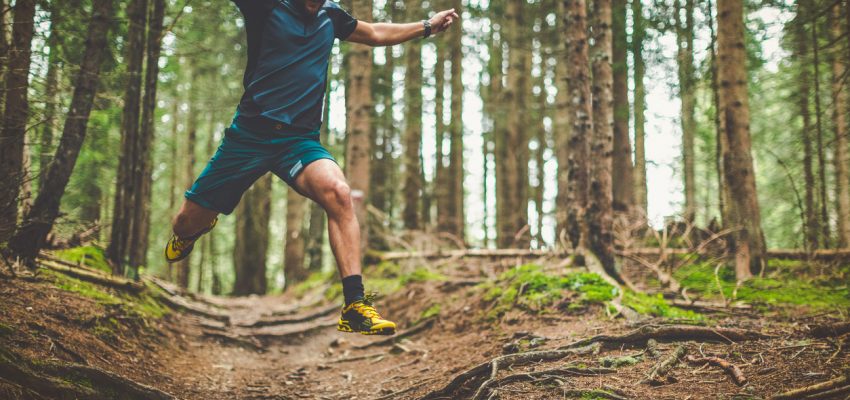Want to run, but the thought of pounding the pavement leaves you in a cold sweat? Trail running incorporates running and hiking over outdoor trails so you get stunning views, a whole bunch of fresh air and it’s easier on your knees.
Improves Mental Health
Running over uneven terrain, and looking out for rocks and tree roots not only activates your muscles and joints, it also stimulates you mentally. The constantly changing nature of the great outdoors means that even your most used trails will never become boring.
A recent Stanford University study found that hiking or running in nature helped to reduce anxiety and depression. People who live in cities have a 20% higher risk of anxiety disorders and a 40% higher risk of mood disorders than those who live in the country.
Shinrin-Yoku or ‘forest bathing’ is the cornerstone of preventative medicine in Japan. Spending time in the woods has been shown to improve focus, reduce stress, improve immune systems and sleep, increase energy level and improve mood. Add that to your exercise regimen and you’re on a roll!
Improves Your Physical Shape & Technique
According to research, trail running can burn up 10% more calories than road running. Due to uneven surfaces, you engage your core muscles for stabilizing which promotes better balance and coordination and improves muscle tone.
Studies show that running on uneven terrain causes you to take shorter, quicker strides and land more on the forefoot than the heel.
Most trails incorporate hills, and running uphill is one of the most effective strength workouts. According to Andy Brooks, professional coach at Peak Running, uneven ground improves ankle strength, flexibility, balance and makes legs stronger.
Increases Heart & Lungs Health
The main benefit of cardio training is that it enhances heart health. You’re also breathing in fresh air rather than city pollution and that also improves your heart health.
Causes Fewer Injuries Than Road Running
Asphalt roads and sidewalks are hard on the joints. All that repetitive stress on the knees and hips can cause injury. Running on the softer surfaces of trails means there is less impact on your joints. If you fall, you are less likely to get seriously injured and you are avoiding the danger of being hit by a car or bike.
Meet New Like-Minded People
Joining a trail-running club or finding a trail buddy will mean that you get to meet other people who share your interests. Running with others is safer and more fun and you’ll discover trails you wouldn’t have found on your own.
Trail Running for Beginners
So you want to hit the trails but don’t know where to start, here’s how:
- Find a Trail
Start with short trails that you are familiar with. Pick one you like and walk it first to familiarize yourself with the terrain. Running on trails is much more taxing than road running, so start with short runs until you have increased your endurance. Forgo the headphones for the first couple of runs — you need to have good situational awareness to ensure that you don’t get injured and that you are aware of any wildlife you may encounter.
- Shoes & Gear
Trail running is an exhilarating experience, but if you don’t have a good pair of trail running shoes, it may turn into a nightmare. A good pair of trail running shoes like CrossFitShoes are essential for safety. These shoes have been designed for the uneven terrain and provide enough support for the arch. They feature a stiff heel, which gives support, stability and provides good grip.
Wear comfortable clothes, made of synthetic moisture-wicking fabric as your attire may get wet or soiled by branches and bushes. Steer clear of cotton as it retains humidity and stays wet.
Wear bright colors so you can be seen during hunting season and won’t be mistaken for a deer.
- Protection against insects
Use bug spray in the warmer months. You don’t need to use the chemical stuff, you can make your own natural sprays for mosquitoes and black flies. Always check for ticks after a run, especially when you have been through long grass. You can make your own tick repellent too.
- Stay Hydrated
Always carry enough water and electrolytes on long runs. The golden rule is to drink 15-20 ounces of water per hour or energy drinks, which supply you with enough electrically-charged minerals (calcium, magnesium, sodium, potassium).
- Focus On Safety
- Avoid trail running during deer hunting season.
- Always let your family or friends know where you are going and when you plan to return;
- Always take a cell phone. If you are going somewhere that there is no signal, download a map so you know your route.
- Take your ID and a list of emergency contacts.
- Always stay aware of your surroundings.
- Run on marked trails.
- Find a friend or a group of runners you can join.
- Know what animals you may encounter on the trail and how to deal with them when you do.





Trail running just makes me feel so good. Sometimes I’m a wee bit reluctant to get out the door, but when I do? I’m so glad that I did it, even if it’s raining or something.
This is very helpful.Thanks for sharing.
This is very helpful.Thanks for sharing
Searching for stuff to reduce my fats and found this post. Trail Running definitely helps in reducing fats. Very Informative blog. Thanks for the article…
Nice Article! Thanks for sharing
Great post I would like to thank you for the efforts you have made in writing this interesting and knowledgeable article.